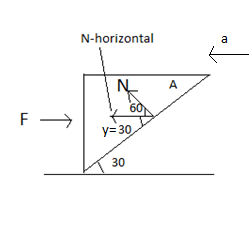Question
Question: Two blocks (A) and (B) each of mass m are placed on a smooth horizontal surface. Two horizontal forc...
Two blocks (A) and (B) each of mass m are placed on a smooth horizontal surface. Two horizontal forces F and 2F are applied on blocks (A) and (B), respectively, as shown in fig. Block (A) does not slide on block (B). Then then the normal reaction acting between the two blocks is (assume no friction between the blocks)

(A) F
(B) 2f
(C) 3f
(D) 3F
Solution
Hint To solve this question we first find the net force on the system and the net mass. We use these two values in the force formula to get acceleration of the entire system. The acceleration of the entire system is also the acceleration of both the blocks. We now draw a free body diagram of one of the blocks to find all the forces acting on it. Adding all the forces acting on the block and substituting the value of acceleration we found earlier in the formula we find the normal force.
Complete Step by step solution The net mass of the system is the sum of masses of both the blocks.
mnet=m+m=2m
The net force acting on the system is the vector sum of both the forces.
Fnet=2F−F=F
From force formula we find the acceleration of the system
Fnet=mneta
a=mnetFnet=2mF
Since the two bodies don’t slide over one another the acceleration of these two bodies is also the same as that of the entire system.
The free body diagram of the block on the left is

The normal force acting on the block is perpendicular to the 30∘ inclined surface.
Converting into the horizontal direction we get
NHor=Ncos60∘
Here,
NHor, is the horizontal component of normal force
N, is the normal force
The angle between the horizontal and the normal force is 60∘ because from alternate internal angels we get y=30∘ degrees and subtracting 90∘ from it we get 60∘ .We subtract 90∘ because the normal force is perpendicular to the surface.
Adding all the forces acting horizontally on block on the left
Ncos60∘−F=ma
Substituting the value of acceleration a=2mF
Ncos60∘−F=m×2mF
⇒Ncos60∘−F=2F
⇒2N−F=2F (∵cos60∘=21)
⇒2N=2F+F=23F
⇒2N=23F
∴N=3F
Hence normal force is equal to 3F
Option (D) 3F is the correct answer.
Note We can also solve this problem by taking the block on right under consideration. But the normal force for this will be in the opposite direction which then makes the horizontal component of the normal force also become opposite compared to the block on the left. The two normal forces cancel which is why the two blocks are at equilibrium with each other.
